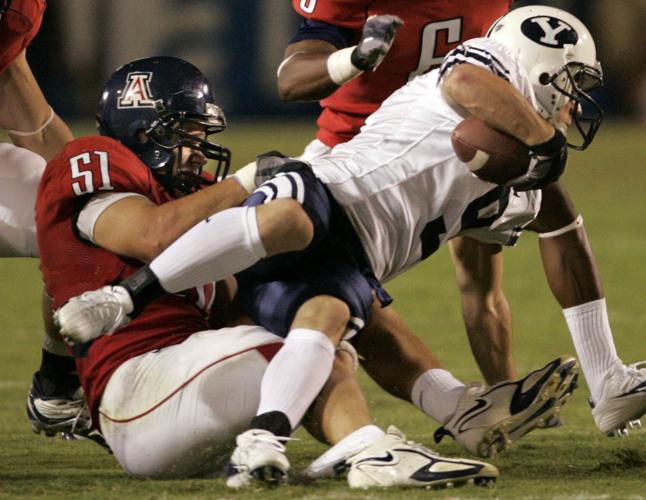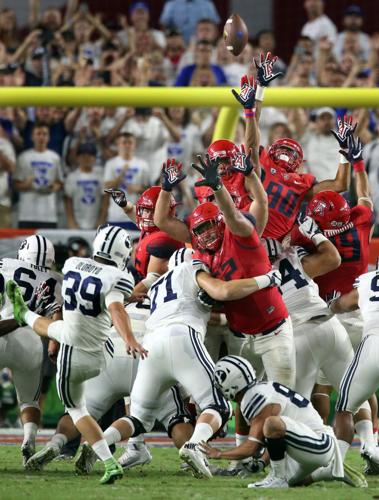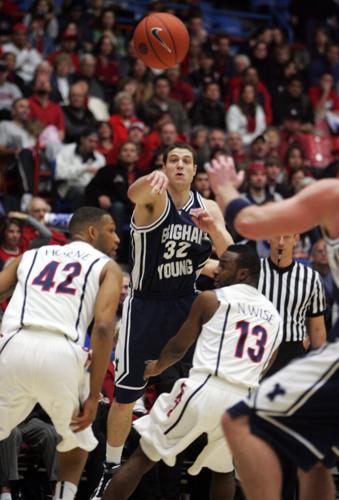(Editor’s note: This is part of the Star’s ongoing “Big 12 Blitz” series, where we introduce U of A fans to the on- and off-field need-to-know details surrounding each member of the new 16-team Big 12. Today: Brigham Young University, located in Provo, Utah.)
The Star's Big 12 Blitz is presented by Tucson Appliance Company.

Tucson Appliance Company has something for everyone! We specialize in new, reconditioned, scratch-and-dent, and high-end appliances. Known for…

is the longtime sports columnist for the
Arizona Daily Starand
Tucson.com.
BYU, we hardly know you.
Or perhaps it’s more accurate to say, we sort of forgot you. The Cougars have only played football in Tucson twice in the last 47 years, twice in men’s basketball.
Before that, from 1957-77, the Cougars were a regular at Arizona Stadium. Nothing special, middle of the pack fodder.

Arizona wide receiver Mike Thomas is brought down by BYU defensive back Ben Criddle during the fourth quarter of the Wildcats' season opener at LaVell Edwards Stadium in Provo, Utah, on Sept. 1, 2007. BYU took this one on its home turf, 20-7.
But when the Wildcats and Cougars split conference affiliations in 1978, BYU took a trajectory that no one in the old WAC conference could’ve seen coming. National champions, 1984. Heisman Trophy winner, 1990. Seven years finishing in the AP’s Top 10.

BYU placekicker Jake Oldroyd chips in the winning field goal over the Arizona line in the Cougars’ 18-16 win over Arizona in the Cactus Kickoff Classic in Glendale on Sept. 3, 2016.
Perspective: Arizona won 71 games in the 1990s, its best-ever decade of football. BYU won 87.
For a few decades, the Cougars seemed to ship a quarterback to the NFL year after year: Jim McMahon. Steve Young. Gifford Nielsen. Heisman winner Ty Detmer. The true Quarterback U.
Coach LaVell Edwards became BYU’s version of Lute Olson. Super Bowl coaching rosters became populated with those from Edwards’ coaching tree: Andy Reid, Brian Billick, Mike Holmgren, as well as big-game college coaches Steve Sarkisian and Kyle Whittingham.
Only those whose tear-stained Arizona football roots run a half-century deep remember that 50 years ago this fall the Cougars became Spoiler U, ruining what looked to be Arizona’s ascent as the game’s nouveau power.

BYU’s Jimmer Fredette threads a pass through an awaiting Arizona defense that included Jamelle Horne, left, and Nic Wise, right, during the first half of the teams’ Dec. 28, 2009, matchup at McKale Center. Fredette scored a still-McKale record 49 points in a 30-point Cougars’ blowout of the Wildcats during Sean Miller’s first season as UA head coach.
That role shifted forever on October 26, 1974 at Arizona Stadium. The Wildcats stalled. The Cougars went into football orbit.
On that fall afternoon in ‘74, Arizona was 6-1 and ranked 16th, its highest regular season rank ever. The Cougars were 0-3-1. Edwards, then in his third year at BYU, didn’t seem to have any more coaching juice than his fired BYU predecessors Tommy Hudspeth, Hal Mitchell and Tally Stevens, three men who coached 16 seasons of sub-.500 football.
BYU had never been ranked in school history, more than 50 years.
But when BYU stunned Arizona that afternoon, 33-17, the Salt Lake Tribune added sauce to the surprise, writing: “The win might easily be the biggest in BYU history.’’
For the next three decades, BYU football never looked back. The Cougars named their stadium after Edwards, attendance soon rose from a dismal 19,597 for a 1973 Arizona-BYU game in Provo, to year-after-year of sellouts at 65,000 per game.
BYU became a national football brand. Arizona became a basketball school.

Arizona's K'Lee Arredondo gets tagged out by BYU's Kristen Delahoussaye in the fourth inning of Game 2 of the the teams' NCAA Softball Tournament Super Regional series at Hillenbrand Stadium in Tucson on May 29, 2010. Arizona won the game 10-2, and the series 2-0 to return to that season's Women's College World Series.
“Arizona’s loss was a terrible blow,’’ the Salt Lake Tribune reported in 1974. “The Wildcats figured on winning this year’s WAC title and going to the Fiesta Bowl.’’
The shock factor at Arizona Stadium that day was so real that BYU cheerleaders grabbed an abandoned “Fiesta Bowl’’ sign from the Zona Zoo section, carried it to the 50-yard line and threw it to the ground.
The LaVell Edwards story is one for the books. The record books.
He grew up in the shadow of BYU’s football stadium and old Lincoln High School. He was not recruited by his hometown BYU Cougars, but rather by the rival Utah State Aggies, 125 miles north, where he became a starting center and team captain.
After two years of military service, Edwards was hired as the football, wrestling and golf coach at Salt Lake City’s newest suburban school, Granite High. Edwards stayed there, mostly obscure, for nine years before getting a job as a BYU assistant.
Talk about the hire of a lifetime.
By 1977, Edwards had been offered head coaching jobs at Miami and Missouri. In 1982, Colorado offered him its coaching vacancy. In 1984, the Detroit Lions hoped to hire Edwards. In 1986, the Texas Longhorns called.
Not interested. Edwards made BYU a lifetime job. He won 257 games as a Cougar. For some perspective, Dick Tomey won 95 games across 14 years at Arizona.
Edwards played at my alma mater, Utah State, whose most despised rival is, yes, BYU. I found it difficult to get past the BYU thing for decades, cheering against the Cougars every chance I got. I was unable to find a place in my heart for a fellow Aggie, perhaps THE Aggie.
But one day in the winter of 2000, shortly after Arizona fired Tomey, I was told that long-time BYU offensive coordinator Norm Chow was one the UA’s “hot list.’’
Edwards had retired a month earlier; I got his phone number from another Aggie, Chris Pella, a long-time BYU assistant coach who has been my friend forever.
I gathered the courage to phone Edwards. He answered on the first ring.

BYU forward Lauren Gustin (12) shoots over Arizona forward Sam Thomas, left, during the first half of the teams' second round NCAA Women's Basketball Tournament matchup on March 24, 2021, at the UTSA Convocation Center in San Antonio. Arizona trailed midway through the fourth quarter, but would climb back to win before going on to reach the Final Four and national title game for the first time in program history.
I Identified myself, asked about Chow, and told him I was a fellow Aggie.
He asked if I knew Jay Van Noy and Earl Lindley, Merlin and Phil Olsen, and several other prominent Aggies. We must’ve talked for 20 minutes. He told me how much he admired Dick Tomey.
My angst for BYU, 50 years strong, vanished that day.
“Norm’s not going to Arizona,’’ Edwards told me. “He’s going to be USC’s offensive coordinator. Keep your eye on John Mackovic.’’
That’s the only time I talked to Edwards, but thereafter my life-long distaste for the Cougars diminished and disappeared.

Arizona's Spencer Larsen drags down BYU's Nathan Meikle in the fourth quarter of the teams' Sept. 2, 2006, matchup at Arizona Stadium in Tucson. The host Wildcats won 16-13 on a game-winning field goal in the waning moments by kicker Nick Folk.
When Arizona was absorbed by the Big 12 a year ago, I found comfort that the Wildcats and Cougars would become big-game rivals in all sports. The relationship that quietly went dark in 1977 has been revived.
Welcome back.
Thanks to 'Big 12 Blitz' presenting partner Tucson Appliance Company, the Star's Michael Lev, Justin Spears and Brett Fera discuss rivals BYU and Utah, and how Arizona squares up to both in football and beyond with the Wildcats and Utes joining the Big 12.
BYU seems like a geographically convenient rivalry-in-waiting for both Arizona and ASU as new Big 12 members, plus a look at college football's "Holy War" (Utah vs. BYU) and more.
Big 12 Blitz is the Star's way of introducing you — the discerning Arizona Wildcat season ticket holder, would-be road-tripper or cardinal and navy-clad die-hard — to the teams, towns, campuses and more UA coaches, athletes and supporters will get to know across the new Big 12 landscape.














